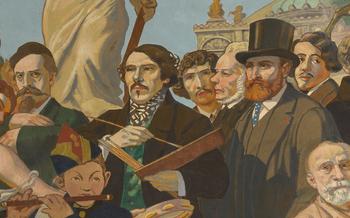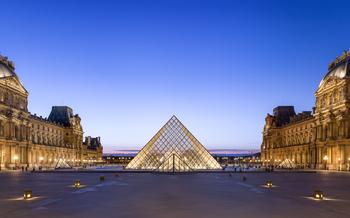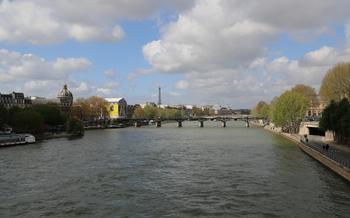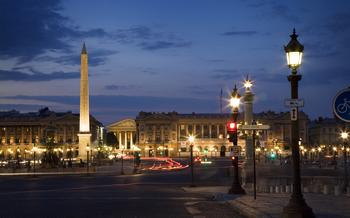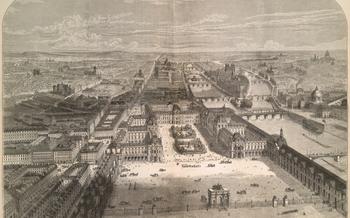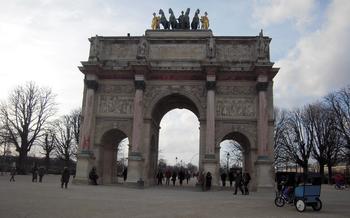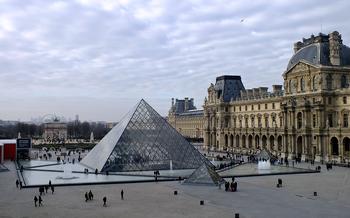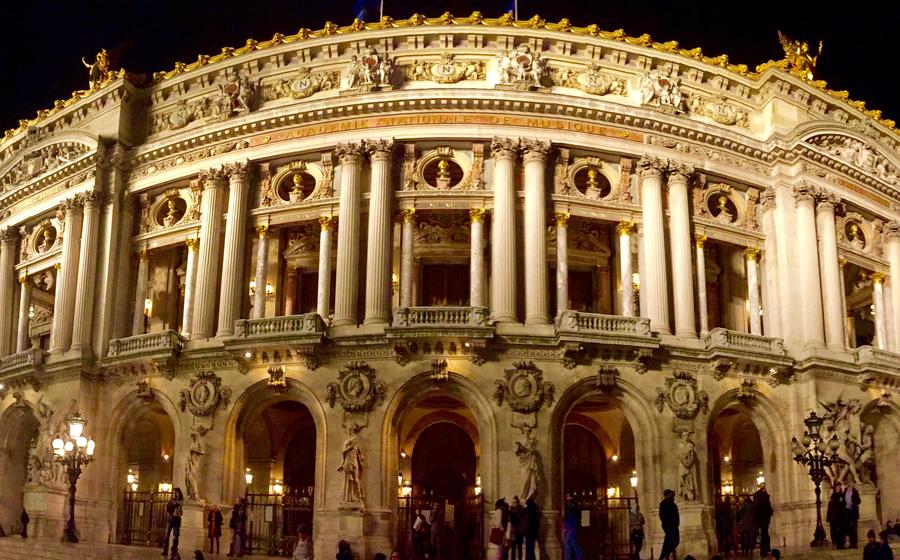
Palais Garnier
- Palais Garnier: A Masterpiece of Opulence and Grandeur
- History of the Palais Garnier
- Architectural Highlights
- Interior Design and Opulence
- Home of the Paris Opera
- Visiting the Palais Garnier
- Ticket Prices and Reservations
- Exploring the Neighborhood
- Dress Code and Etiquette
- The Phantom of the Opera Connection
- Other Must-See Attractions Nearby
- Photography and Social Media
- Accessibility for Visitors with Disabilities
- Insider Tip: Hidden Gems to Discover
Palais Garnier: A Masterpiece of Opulence and Grandeur
The Palais Garnier, often regarded as one of the world's most magnificent opera houses, stands as a testament to the grandeur and opulence of the Second French Empire. Its construction, commissioned by Emperor Napoleon III and designed by architect Charles Garnier, was a symbol of France's cultural and artistic prowess. The Palais Garnier has since become a cultural icon, renowned for its architectural marvels, lavish interior design, and significant contributions to the world of opera and ballet.
Historically, the Palais Garnier was built to replace the previous opera house, which had become too small to accommodate the growing demand for opera and ballet performances. The new opera house was conceived as a grand palace dedicated to the arts, reflecting the emperor's desire to create a magnificent symbol of France's cultural achievements.
Architecturally, the Palais Garnier is a masterpiece of Neo-Baroque style, adorned with intricate sculptures, a majestic dome, and a grand facade. Its opulent interior features a lavish Grand Foyer, a sweeping Grand Staircase, and an ornate auditorium adorned with a magnificent chandelier. The Palais Garnier's grandeur extends beyond its main spaces, with hidden treasures and secret corners waiting to be discovered.
History of the Palais Garnier
The Palais Garnier, a symbol of Parisian grandeur, owes its existence to the vision of Emperor Napoleon III. In 1860, he commissioned the construction of a new opera house to replace the aging Salle Le Peletier. The task of designing this architectural masterpiece fell upon the shoulders of Charles Garnier, a young and talented architect who would go on to leave an indelible mark on Parisian history.
Garnier's design was audacious and ambitious, reflecting the emperor's desire for a building that would rival the great opera houses of Europe. The construction faced numerous challenges, including the complex geology of the site and the outbreak of the Franco-Prussian War in 1870. Despite these setbacks, Garnier persevered, and the Palais Garnier was finally inaugurated in 187
The opening night was a grand affair, attended by the emperor and his court. The Palais Garnier had become the heart of Parisian cultural life, a stage for the world's greatest operas and ballets. Its inauguration marked a new era in the history of the Paris Opera, setting the stage for centuries of artistic excellence and innovation.
Architectural Highlights
The Palais Garnier stands as a testament to the grandeur and opulence of the Neo-Baroque architectural style. Its imposing facade is adorned with intricate sculptures, capturing the essence of mythology and allegory. The grand entrance, flanked by majestic columns, welcomes visitors into a world of artistic splendor. Above the facade, the majestic dome and lantern soar into the Parisian sky, offering a breathtaking spectacle. The meticulous attention to detail, from the ornate carvings to the delicate moldings, showcases the exceptional craftsmanship that went into creating this architectural masterpiece. Every corner of the Palais Garnier reveals a new layer of artistic brilliance, inviting visitors to embark on a journey through the history and beauty of French architecture.
Interior Design and Opulence
The Palais Garnier's interiors are a testament to the opulence and grandeur of the Second Empire. The Grand Foyer, a vast and resplendent hall, welcomes visitors with its shimmering chandeliers, intricate ceiling frescoes, and polished marble floors. The Grand Staircase, a masterpiece of architectural design, sweeps upwards from the Grand Foyer, adorned with ornate balustrades, sculptures, and mirrors that create a sense of awe and wonder.
The auditorium, the heart of the Palais Garnier, is a symphony of visual splendor. The horseshoe-shaped seating arrangement provides excellent acoustics and sightlines, while the plush red velvet seats and gilded balconies create an atmosphere of luxury and elegance. The centerpiece of the auditorium is the chandelier, a magnificent masterpiece weighing over seven tons, adorned with crystal prisms that sparkle and shimmer, casting a radiant glow over the entire space.
Beyond the main attractions, the Palais Garnier is replete with hidden treasures and secret corners. The Salon de la Lune and the Salon du Soleil, intimate and exquisitely decorated lounges, offer a glimpse into the opulent lifestyle of the era. The Bibliothèque-Musée de l'Opéra, a treasure trove of opera and ballet history, houses a vast collection of costumes, set designs, and other artifacts that provide a fascinating insight into the world of performing arts.
Home of the Paris Opera
The Palais Garnier is not just a architectural marvel; it is also the home of the prestigious Paris Opera, one of the world's leading opera companies. For over 150 years, the opera house has staged world-class performances of opera and ballet, attracting audiences from around the globe.
The Paris Opera boasts a rich history dating back to the 17th century. In 1669, King Louis XIV granted a monopoly on opera performances to the Académie Royale de Musique, which later became the Paris Opera. The company performed in various locations throughout Paris until the Palais Garnier was built specifically for them.
The Palais Garnier has witnessed countless legendary performances and premieres over the years. It was here that Giuseppe Verdi's masterpiece "Aida" was first performed in 1887, captivating audiences with its grand sets and unforgettable music. The opera house has also been the stage for world-renowned ballet productions, such as Tchaikovsky's "Swan Lake" and "The Nutcracker."
Attending a performance at the Palais Garnier is a truly unforgettable experience. The auditorium, with its plush red velvet seats and ornate chandeliers, creates an atmosphere of grandeur and elegance. The acoustics are superb, allowing the voices of the singers and the music of the orchestra to soar through the hall.
Beyond its performances, the Palais Garnier also offers behind-the-scenes tours that provide a glimpse into the fascinating world of opera and ballet. Visitors can explore the rehearsal rooms, costume workshops, and stage machinery, gaining insights into the dedication and artistry that goes into each production.
Visiting the Palais Garnier
Exploring the Palais Garnier is an immersive experience that can be tailored to your preferences. Guided tours, led by knowledgeable experts, provide a comprehensive journey through the opera house's history, architecture, and cultural significance. Audio guides offer a self-paced tour, allowing you to discover the Palais Garnier's secrets at your own rhythm.
For a more intimate experience, opt for a self-guided tour. Wander through the grand spaces, admiring the intricate details and imagining the stories that unfold within these walls. Take your time to explore the hidden nooks and corners, discovering hidden treasures that often go unnoticed.
The Palais Garnier is committed to accessibility. Wheelchair ramps and elevators ensure that visitors with disabilities can fully experience the opera house. Assisted listening devices are available for those who need them, ensuring an inclusive experience for all.
To make the most of your visit, plan your trip in advance. Check the Palais Garnier's website for performance schedules, guided tour availability, and ticket prices. Advance booking is recommended to avoid disappointment, especially during peak tourist season.
Whether you choose a guided tour, an audio guide, or a self-guided exploration, the Palais Garnier promises an unforgettable experience. Immerse yourself in the grandeur, history, and cultural significance of this iconic Parisian landmark.
Ticket Prices and Reservations
Visiting the Palais Garnier is a unique experience, and ticket prices reflect its historical and cultural significance. Full-price tickets for a guided tour of the Palais Garnier start at around €15, while concessions for students, seniors, and families are available at a reduced rate of €
Advance booking is highly recommended, especially during peak tourist season, to secure your spot and avoid long lines. Tickets can be purchased online or at the Palais Garnier box office.
Special events and performances may require higher ticket prices, so it's essential to check the official website or contact the box office for specific information. Keep an eye out for discounts and promotions offered throughout the year, which can help you save on your visit.
Exploring the Neighborhood
The Palais Garnier is not just a standalone attraction; it is nestled within the charming Opera district of Paris, a vibrant neighborhood brimming with cultural significance. Take advantage of your visit to explore the surrounding area and discover its many hidden gems.
Stroll along the picturesque streets, admiring the elegant Haussmannian architecture that characterizes the neighborhood. Visit the nearby Galeries Lafayette and Printemps department stores, renowned for their fashion and luxury goods. Indulge in a delicious meal at one of the many restaurants or cafes, offering a diverse range of cuisines from around the world.
Don't miss the iconic Place Vendôme, a beautiful square surrounded by luxurious boutiques and jewelry stores. Admire the majestic column in the center, a symbol of Napoleon Bonaparte's victories. Take a leisurely walk through the Tuileries Garden, a stunning park with manicured lawns, sculptures, and fountains, offering a tranquil oasis in the heart of the city.
Immerse yourself in the cultural heritage of the area by visiting the Musée de l'Orangerie, which houses a collection of Impressionist and Post-Impressionist masterpieces, including works by Monet, Renoir, and Cézanne. Discover the history of the French Revolution at the Conciergerie, a former prison that once held Marie Antoinette and other notable figures.
The Opera district is a vibrant tapestry of history, culture, and Parisian charm. Explore its streets and discover the hidden treasures that await you around every corner.
Dress Code and Etiquette
The Palais Garnier is a renowned cultural institution that demands a certain level of decorum and respect. While there is no strict dress code, visitors are encouraged to dress appropriately for the occasion. Formal attire, such as suits or evening gowns, is not mandatory but is often seen during special events and performances. Smart casual attire is generally acceptable, ensuring comfort while maintaining a respectful demeanor.
During performances, it is essential to observe proper etiquette to ensure a seamless and enjoyable experience for all attendees. Arriving on time is crucial, as latecomers may disrupt the performance and inconvenience other patrons. Once the performance begins, silence is expected as a sign of respect for the artists and fellow audience members. Refraining from talking, using mobile phones, or engaging in disruptive behavior is essential.
Following these guidelines for dress code and etiquette demonstrates respect for the Palais Garnier's rich history, cultural significance, and the performers who grace its stage. By adhering to these norms, visitors contribute to maintaining the ambiance and integrity of this esteemed opera house.
The Phantom of the Opera Connection
The Palais Garnier has a captivating connection to the world-renowned novel "The Phantom of the Opera" by Gaston Leroux. The grandeur and mystique of the opera house inspired Leroux to set his story within its walls, weaving a tale of love, tragedy, and the haunting presence of the Phantom.
The novel has immortalized the Palais Garnier, turning it into a symbol of mystery and intrigue. Visitors can explore the places associated with the story, such as the subterranean lake, the Phantom's lair, and the iconic chandelier that crashes during a performance.
The Palais Garnier's connection to "The Phantom of the Opera" has made it a popular destination for fans of the novel and the musical adaptation. Visitors can immerse themselves in the world of the Phantom and experience the magic of this timeless tale.
Other Must-See Attractions Nearby
A visit to the Palais Garnier can be effortlessly combined with other iconic landmarks in the surrounding area, creating a comprehensive Parisian adventure. Just a short stroll away lies the world-renowned Louvre Museum, housing masterpieces such as the Mona Lisa and Venus de Milo. Immerse yourself in art history as you wander through its grand galleries.
Adjacent to the Louvre, the serene Tuileries Garden offers a tranquil respite amidst the city's hustle and bustle. Stroll along its manicured paths, admire the sculptures and fountains, or simply relax and soak up the Parisian atmosphere.
At the western end of the garden, you'll find the majestic Place de la Concorde, one of the largest squares in Paris. Marvel at the towering Luxor Obelisk, a relic from ancient Egypt, and take in the breathtaking views of the Eiffel Tower in the distance.
Continue along the Champs-Élysées, Paris's most famous avenue, and you'll reach the Arc de Triomphe, a symbol of French military victories. Ascend to the viewing platform atop the arch for panoramic city views that will leave you breathless.
By combining your visit to the Palais Garnier with these nearby attractions, you'll create a truly memorable Parisian experience that showcases the city's rich history, art, and culture.
Photography and Social Media
The Palais Garnier is a photographer's paradise, with endless opportunities to capture its architectural grandeur and opulent interiors. While you're free to take pictures in most areas, be mindful of any signs or instructions that may prohibit photography in certain sections. Using a flash is generally not allowed as it can disrupt performances and damage delicate artworks.
When sharing your photos on social media, be sure to tag the Palais Garnier and use relevant hashtags such as #PalaisGarnier, #OperaGarnier, and #ParisOpera. This will help others discover your content and connect with fellow enthusiasts.
The Palais Garnier is a source of inspiration for many. Share your experiences, tag your friends, and let the world see the beauty of this architectural masterpiece through your lens. Remember to be respectful of the venue, its staff, and other visitors, and always prioritize the safety and enjoyment of everyone present.
Accessibility for Visitors with Disabilities
The Palais Garnier is committed to ensuring an inclusive and accessible experience for all visitors, regardless of their abilities. The opera house features wheelchair-accessible ramps, elevators, and designated seating areas to accommodate guests with mobility challenges. Assisted listening devices are available upon request for those with hearing impairments. Visitors with visual impairments can benefit from touch tours and audio-described performances. The friendly and helpful staff is always ready to assist visitors with disabilities, providing directions, assistance with seating, and any other support needed to ensure a comfortable and enjoyable visit. By prioritizing accessibility, the Palais Garnier strives to create a welcoming environment where everyone can experience the magic of opera and ballet without barriers.
Insider Tip: Hidden Gems to Discover
Beyond the main attractions, the Palais Garnier conceals a treasure trove of hidden gems waiting to be discovered. Explore the mesmerizing underground lake beneath the opera house, a secret reservoir that once provided water for the building's operations. Discover the hidden passageways and staircases that lead to secluded corners and forgotten spaces, offering unique perspectives of the opulent interior. Don't miss the Musée du Palais Garnier, a small museum tucked away within the building, showcasing fascinating exhibits on the history, architecture, and behind-the-scenes workings of the opera house. These hidden gems add an air of mystery and intrigue to your visit, providing a glimpse into the lesser-known secrets of this iconic Parisian landmark.
